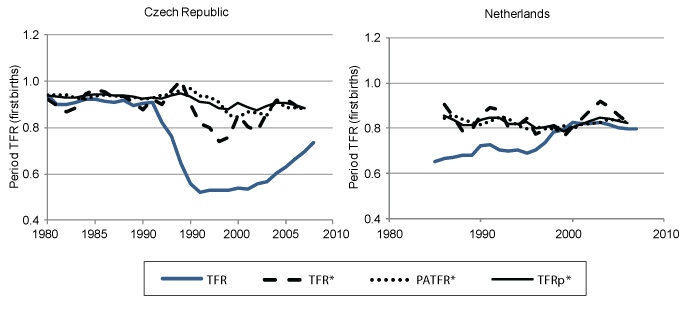Recent trends in the tempo-adjusted TFR*
Even though the best tempo-adjusted period measure of fertility will never quantify cohort quantum, tempo-adjusted measures of period fertility can help us interpret contemporaneous fertility trends. This is illustrated in Figure 6. Aside from the period TFR and the Bongaarts-Feeney TFR*, this figure also illustrates trends in two other tempo-adjustments: the PATFR* proposed by Kohler and Ortega (2002), and the TFRp* proposed by Bongaarts and Feeney (2006). These plots demonstrate that the low fertility rates in the 1980s (Netherlands) and 1990s (Czech Republic and the Netherlands) were at least in part the product of tempo effects (the tempo-adjusted fertility measures are all higher than the observed fertility rates). More recently, the period TFR again increased in both countries, but the tempo-adjusted measures have not followed suit. Bongaarts and Sobotka (2012) largely attribute this increase in the unadjusted period TFR to the diminishing pace of the postponement of childbearing (i.e., the end of the downward bias in the period TFR). In other words, the recent increase in the period TFR is not necessarily the result of a quantum increase in fertility, but mostly likely due to tempo distortions, yet again.

Figure 5: Trends in observed and tempo-adjusted TFR indices in the Czech Republic and the Netherlands
Source: Adapted from Bongaarts & Sobotka (2012)